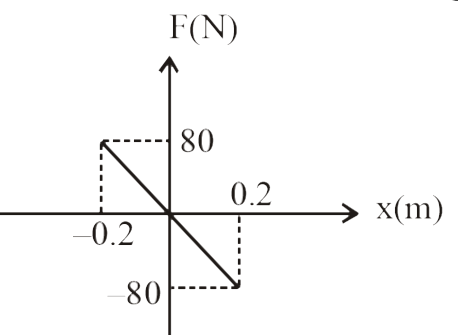A body of mass 0.01 kg executes simple harmonic motion about x = 0 under the influence of a force as shown in figure. The time period of SHM is

1.05 s
0.52 s
0.25 s
0.03 s
Step by step video & image solution for A body of mass 0.01 kg executes simple harmonic motion about x = 0 under the influence of a force as shown in figure. The time period of SHM is by Physics experts to help you in doubts & scoring excellent marks in Class 11 exams.
Similar Questions
A block of mass 5 kg executes simple harmonic motion under the restoring force of a spring. The amplitude and the time period of the motion are 0.1 m and 3.14 s respectively. Fnd the maximum force exerted by the spring on the block.
View SolutionA body is executing simple harmonic motion under the action of a force F1 with time period 1 s. The time period is 2s when body is acted by another force F3. What will be the total time period when both the forces are acting in same direction simultaneously ?
View Solution
Knowledge Check
- Question 1 - Select One
A body of mass 0.01 kg executes simple harmonic motion (SHM) about x=0 under the influence of a force shown in the figure. The period of the SHM is
 A1.05 sB0.52 sC0.25 sD0.31 s
A1.05 sB0.52 sC0.25 sD0.31 s - Question 2 - Select One
A block of mass 2kg executes simple harmonic motion under the reading from at a spring .The angular and the time period of motion are 0.2cm and 2πsec respectively Find the maximum force execute by the spring in the block.
A0.05NB0.002NC0.003ND0.004N - Question 3 - Select One
A particle executes simple harmonic motion under the restoring force provided by a spring. The time period is T. If the spring is divided in two equal parts and one part isused to continue the simple harmonic motion, the time period will
Aremain TBbecoem 2TCbecome T/2Dbecome T√2
A particle of mass 0.50kg executes a simple harmonic motion under a forve F=−(50n/m)x. If crosses the centre of oscillation with a speed of 10m/s, find the amplitude of the motion.
View SolutionA particle of mass 0.50 kg executes a simple harmonic motion under a force F = – (50 N/m)x. If it crosses the centre of oscillation with a speed of 10 m/s, find the amplitude of the motion.
View SolutionA particle of mass 0.50 kg executes a simple harmonic motion under a force F=−(50Nm−1)x. If it crosses the centre of oscillation with a speed of 10ms−1, find the amplitude of the motion.
View SolutionA body of mass 0.1 kg is executing a simple harmonic motion of amplitude 0.2 m. When the body passes through the mean position, its kinetic energy is 8×10−3 J. The initial phase of oscillation is 60. What is the equation of motion of the body ?
View SolutionA body executes simple harmonic motion under the action of a force F1 with a time period 45s . If the force is changed to F2, it executes SHM with time period 35s. If both the forces F1andF2 act simultaneously in the same direction on the body, its time period (in seconds) is
View Solution

